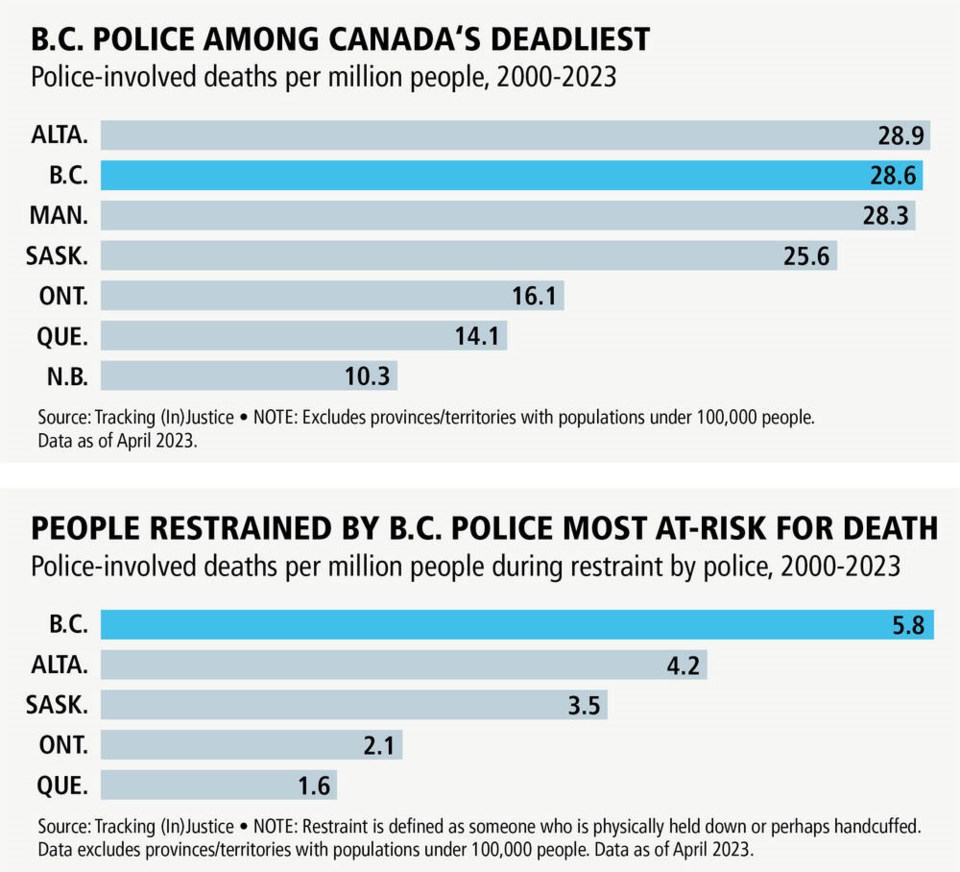The death of Myles Gray at the hands of Vancouver police in 2015 appears to be just one story in a larger trend of killings by police in the province, according to a Postmedia analysis of such deaths across the country.
Since 2000, 143 people have been killed by police in B.C. — more than any province other than more populous Ontario, according to data from Tracking (In)Justice, a project tracking police killings in Canada.
It works out to almost 29 for every million people in B.C., the highest rate of any province or territory except Nunavut and Alberta.
“We’ve seen a rise in police-involved deaths across Canada,” said Alexander McClelland, assistant professor at Carleton University’s institute of criminology and criminal justice and principal investigator at the Tracking (In)Justice project.
McClelland said researchers track media reports of police-involved deaths, which are then verified using information from police oversight bodies, including B.C.’s Independent Investigations Office.
In B.C., about two-thirds of police-involved deaths since 2000 were a result of shootings, the lowest proportion of any Canadian police force.
But more people have been killed while being restrained by police in B.C. than in any province except Ontario. Since 2000, 29 people have died while being restrained by B.C. police. That works out to nearly six out of every million people in the province — almost three times higher than in Ontario and over 30 per cent higher than second-ranked Alberta.

“It’s obvious that B.C. has a disproportionate rate of police-involved deaths,” said Meghan McDermott, policy director with the B.C. Civil Liberties Association.
McDermott said the figures confirmed “what we hear from communities about how much violence is inflicted by the police, both by municipal agencies and the RCMP themselves.”
Deaths categorized as “restraint” include people who have been physically held down or potentially handcuffed, according to the Tracking (In)Justice project — exactly the situation that occurred in the death of Myles Gray.
Gray died in August 2015 after a beating by several VPD officers that left him with injuries including a fractured eye socket, a crushed voice box and ruptured testicles.
Gray was handcuffed and his legs were tied together when he stopped breathing and went into cardiac arrest. First responders tried to revive Gray for about 40 minutes until he was pronounced dead at the scene.
The Independent Investigations Office recommended criminal charges be laid against officers involved in Gray’s death but the B.C. Prosecution Service announced in 2020 that charges would not be approved against the officers, saying police were the only witnesses to the incident and the Crown couldn’t prove an offence had been committed.
VPD officers were involved in over a quarter of restraint-involved deaths in B.C. since 2000, including the death of Myles Gray. However, in the eight years since Gray’s death, there have been no VPD-related deaths involving restraint.
“As the province’s largest police agency serving the biggest population, there are more interactions that require police to use force,” wrote Steve Addison, a media relations officer with the VPD.
“We are also a core city that draws hundreds of thousands more from other areas of Metro Vancouver,” he added. “Incidents requiring the use of force are extremely rare.”
The figures show that the VPD are involved in deaths at a significantly higher rate than other police services in B.C., however.
Of the 143 police-involved deaths in B.C. since 2000, 30 were attributed to the VPD — about 21 per cent on the total. Vancouver accounts for 13 per cent of B.C.’s population.
RCMP were involved in 98 of the deaths, but the data does not indicate which RCMP detachments were involved.
Six deaths involved Victoria police, and three involved Saanich police. (The totals for both municipalities include the deaths of Mathew and Isaac Auchterlonie, brothers from the Cowichan Valley who robbed a bank in Saanich last June.) Of the seven people killed, six were shot and one person was being restrained.
McClelland said the project to track police killings was driven by a lack of transparency among Canadian police forces — publicly-funded institutions he said routinely fail to share data that other government offices regularly provide.
“I can tell you how much rain there was in Ottawa last year. I can tell you how many car accidents there were in New Brunswick,” McClelland said. “But we can’t consistently tell anyone how many people the police have killed each year.”
— With files from Times Colonist and The Canadian Press



